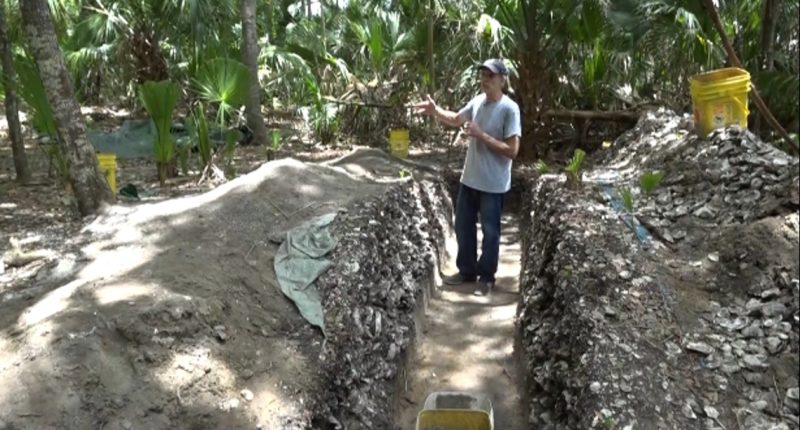Share this @internewscast.com

Archaeologist Keith Ashley, along with a group of students from the University of North Florida and other colleges, has encountered an unusual find.
JACKSONVILLE, Fla. — An intriguing discovery in the forested area of the Timucuan Ecological and Historical Preserve in Jacksonville is puzzling archaeologists.
They says what they’ve found is unique for its time period — a thousand years ago.
Archaeologist Keith Ashley and his team from the University of North Florida and other institutions have uncovered something that is unfamiliar even to him.
“It’s so different than any other site of the exact same time period,” Dr. Ashley said.
The discovery: lots and lots of substantial shell mounds — or middens — in formations not seen in other Native American sites, he said.
“They’re really massive and they’re really large,” Ashley said.
The shell mounds range in size, from 100-feet-long to the length of two football fields. Some are even three feet tall.
Ashley said, “They date to about 1,000 years ago.”
He said Timucuan speakers would have built them.
Certainly, shell mounds made of oyster and clams shells are common on Native American sites. However, Ashley noted the size and shape at this location are completely different for this time period.
But what were the mounds for?
“We were thinking that maybe this is a place where people from these different communities come together, collect things in large numbers, maybe have ceremonies and rituals, and then deposit things to commemorate something,” Ashley said. “Are they commemorating some sort of celestial event? Are they commemorating something within their history? We don’t know, but this is just a unique way to lay out your garbage and putting a lot of work into it.”
University of Florida Graduate Student Victoria Hayes is working at the dig site. She said, “I’m looking at some newer software and looking at archaeo-astronomy. So I’m looking at how these shell configurations potentially align with celestial events or the solstice or equinoxes. I would think that the moon phases would be really important to them because of the tides.”
She added, “So I’m looking at that specifically to see if there’s any correlation there because a lot of the shell formations more inland. parallel each other, in size and shape and height. So it looks very purposeful.”
Often, it’s not easy to see the ridges in the forest if you’re not looking for them. Brush and leaves cover them. However, Lidar has made it easer. Lidar — which stands for Light Detection and Ranging — is a remote sensing method used to examine the surface of the Earth. It provides a digital elevation model, and with it, the mounds or ridges stand out on a map.
Ashley’s team is also finding quite a bit of pottery sherds, especially for one kind of pot.
Hayes said, “It looks like all of the pots out here are entirely cooking pots.”
So on this site, 1,000 years ago, it appears cooking, gathering and possibly ceremonies took place.
“We want to understand the indigenous history, the dep long term indigenous history,” Ashley noted northeast Florida history started long before the first Europeans arrived, but “in reality it goes back 13,000 years. So when you think about the human history of Northeastern Florida, 97% of that is an indigenous history.”

















